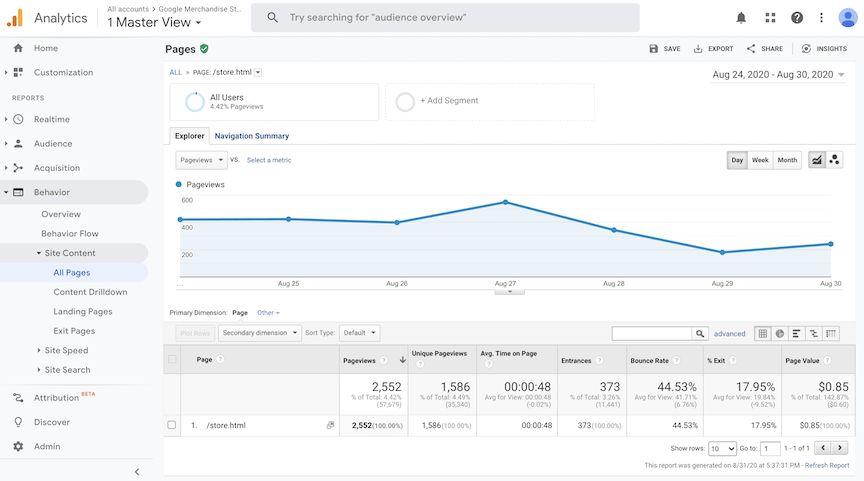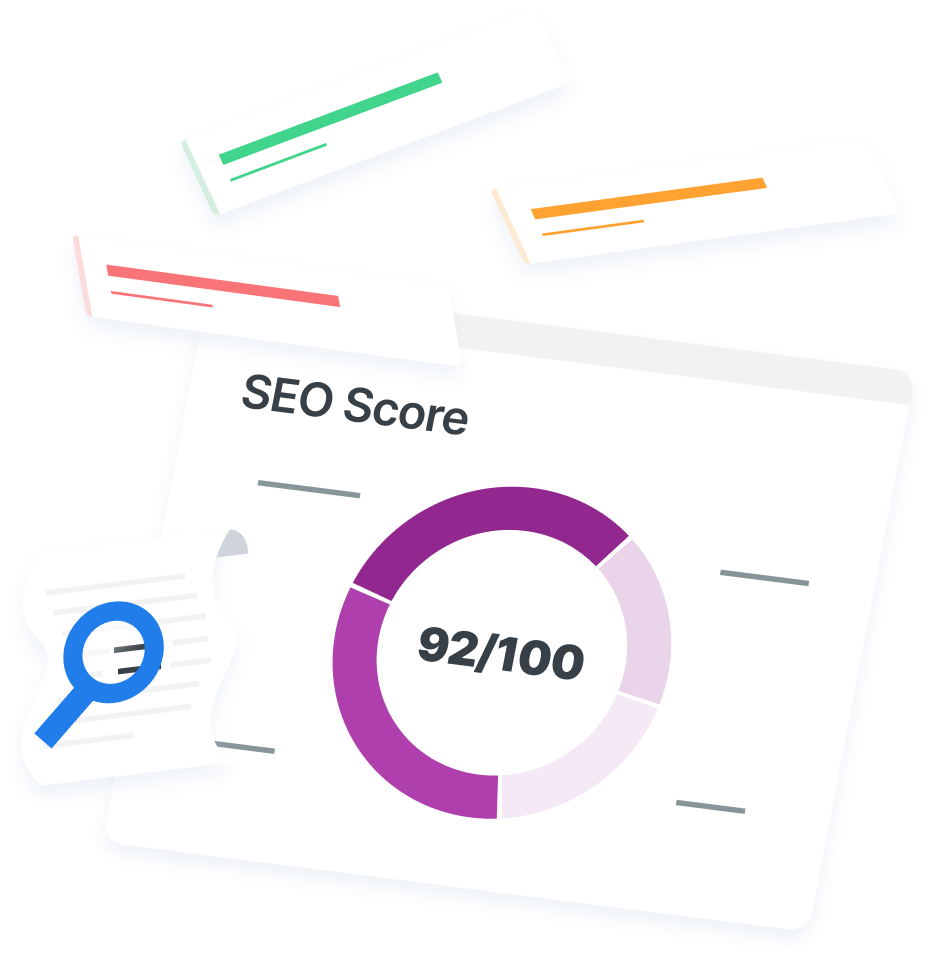-
 7 min. read
7 min. read
-
 Sarah Berry
Sarah Berry Web Marketing Consultant
Web Marketing Consultant
- Sarah Berry is a Google Analytics-certified Web Marketing Consultant at WebFX. She’s written over 400 articles on digital marketing, covering topics like SEO, CRO, and Amazon. When she isn’t polishing her Time Magazine Person of the Year Award, she’s spending time with her flock of ducks.
Most of the time, when you want to improve your website’s search engine rankings, you add content. Maybe you want to target a new keyword, so you write a blog post based on it. Perhaps you want to improve a page’s ranking, so you add a video or some search engine optimization (SEO)-friendly copy to it. While adding content is often an appropriate approach, removing website content can also improve your rankings under the right circumstances.
This optimization tactic is called content pruning SEO. Keep reading to learn more about this valuable SEO tactic! Want to quickly evaluate your website’s SEO performance?
Try our free SEO checker tool! Or, contact us to learn about our SEO audit services. SEO Checker provides data on key metrics to give you:Looking for an all-in-one SEO audit tool? You’ve found it.

What is content pruning for SEO?
Content pruning for SEO involves removing outdated, low-performing, or thin content from your website to improve your overall SEO performance.
Much like pruning unhealthy branches from a tree improves its overall health, removing “dead weight” content from your website helps it perform better in search.
What are the benefits of content pruning SEO?
Regularly pruning your content is important for your search engine performance and the overall quality of your website. The benefits of website content pruning include:
Improved content quality
When you remove low-quality content from your website, it improves your website’s quality overall. This removal eliminates the risks of visitors landing on a low-quality page, which could leave them with a negative impression of your brand.
Removing website content that’s poor quality can lead to Google viewing your site as higher quality and more authoritative as well, boosting your search rankings.
Better user experience
Another one of the top benefits of content pruning is improved user experience. When you remove outdated, thin, or otherwise low-quality content, visitors will enjoy using your site more and find it more valuable. When people view your site as useful and spend more time on it, your rankings tend to go up.
Improved link distribution
The more authoritative a page is, the better a link from that page is for your rankings.
When you remove low-quality pages from your site, your internal linking only involves higher-authority pages and has a more powerful positive impact on your SEO. When you remove the possibility of linking to lower-quality pages through website content pruning, all of your backlinks, which are links from other websites, will also go to high-quality pages.
Improved crawling and indexing
Google needs to crawl the pages on your website for them to show up in search results. Google’s bots can only crawl a certain number of pages on your site each day — a concept referred to as crawl budget.
By removing the low-quality content from your site, you increase the chances of Google crawling your high-quality content. As a result, Google will crawl your most important pages faster.
How to prune your content
To prune your content and improve your search engine rankings, follow this four-step content pruning SEO process.
1. Identify your content
Before you can start pruning your content, you need to know what’s on your site. Create a list of the content on your site if you don’t already have one. You can do this manually, especially if you have a small website.
You can also use various tools to help you. If you have an XML or HTML sitemap for your website, you can use this to get an idea of what’s on your site. You can use a sitemap generator to help you create one if you don’t have one yet.
If you use a content management system (CMS), you may be able to use it to identify the content on your site. On WordPress, for example, you can use a plugin called Export All URLs. Another option is to use a tool such as Screaming Frog, which can crawl your website and provide you with a list of your URLs.
2. Gather data about your content
Next, collect data about how your content performs. You can use tools such as Google Analytics, Google Search Console, Ahrefs, and SEMrush to collect data about your pages. Some of the data you’ll want to collect is:
- Organic search rankings
- The keywords a page is ranking for
- Organic traffic
- Conversions
- Number of backlinks
- Average session duration
- Bounce rate
In this Google Analytics report, for example, you can see the page views, average time on page, bounce rate, and other metrics for the URL being analyzed.  Add all this information to a spreadsheet. It’s also helpful to note information such as the title tag, meta description, H1 heading, word count, and publish date, for each URL.
Add all this information to a spreadsheet. It’s also helpful to note information such as the title tag, meta description, H1 heading, word count, and publish date, for each URL.
3. Evaluate your content
Next, assess your content and look for things you may want to prune. Some types of content to check for are:
- Low-performing content: Check for low-performing content, such as pages that are ranking poorly in search, have a high bounce rate, or get minimal conversions. Of course, consider the goal of the page when assessing its performance — not all pages, for example, are designed for conversions.
- Thin content: Thin content is content that provides little or no added value to the user, such as pages that contain duplicate content, are stuffed with keywords, or don’t accurately answer the user’s question. Poor performance and low word count are signs of thin content.
- Outdated content: Check for outdated content that no longer provides much value to users. Try searching for pages that mention dates and years. Also, check the content that contains statistics or is based on time-sensitive news or events.
- Cannibalistic content: Look for pages that are similar to each other and targeting the same keywords. You can find this content by looking at the keywords for which each page ranks. Pages that are too similar may “cannibalize” each other in rankings, worsening search performance for both pages.
As you go through your content, take note of everything that might be low-performing, thin, outdated, or cannibalistic.
4. Decide what to do with your content
Now, we’re not advocating simply deleting all of your content that might be low-performing, thin, outdated, or cannibalistic. Instead, content pruning SEO requires evaluating each page carefully and then deciding what to do with it. You have several options for what to do with your content:
- Updating: Consider updating your content by substituting more recent facts and statistics, adding content, and otherwise improving it.
- Consolidation: You can also consolidate several pages into one to eliminate duplicates and create a more comprehensive resource. Make sure you use a 301 redirect to indicate the change.
- De-indexing: Some pages might be useful to your users on your website but not in search results. Examples include blog category pages and post-purchase thank-you pages. One of the best ways to de-index a page is to add a ‘noindex’ tag to the <head> section of your page’s HTML.
- Deleting: If you don’t think it’s worth doing any of the three options above, you can delete the page. While it can be hard to get rid of content you put time into in the past, doing so can improve your entire website’s SEO performance.
How often should you prune your content?
It’s best to conduct content pruning SEO work on an ongoing basis. If you created a long list of content to potentially prune, work on it gradually while also adding new content to your site. Start with the content you expect is of the lowest quality.
Once a month, go through your content and look for pages you could prune to keep your site fresh and improve your search rankings.
Improve your website content and search engine rankings with WebFX
Keeping your website up to date and ensuring your content is as high-quality as possible is key to maximizing your search engine performance. To accomplish that, you need to periodically review and sometimes prune your content. For a quick evaluation of your SEO, try our free SEO checker tool.
Just input your URL, and you’ll get a detailed SEO report in less than 60 seconds. The easiest way to get a comprehensive look at your site’s SEO is with our professional SEO audit services. Our team will thoroughly assess various factors affecting your website’s search engine performance, and we can implement updates to improve your SEO.
Request your free quote or call us today at 888-601-5359 to learn more.
-
 Sarah Berry is a Google Analytics-certified Web Marketing Consultant at WebFX. She’s written over 400 articles on digital marketing, covering topics like SEO, CRO, and Amazon. When she isn’t polishing her Time Magazine Person of the Year Award, she’s spending time with her flock of ducks.
Sarah Berry is a Google Analytics-certified Web Marketing Consultant at WebFX. She’s written over 400 articles on digital marketing, covering topics like SEO, CRO, and Amazon. When she isn’t polishing her Time Magazine Person of the Year Award, she’s spending time with her flock of ducks. -

WebFX is a full-service marketing agency with 1,100+ client reviews and a 4.9-star rating on Clutch! Find out how our expert team and revenue-accelerating tech can drive results for you! Learn more
Try our free SEO Checker
Boost your site’s search performance with our free SEO Checker. Analyze your website for optimization tips on titles, headers, content, speed, and more. Get a free report now to enhance rankings on Google, Bing, Yahoo, and beyond!



How Is Your Website’s SEO?
Use our free tool to get your score calculated in under 60 seconds.
Try our free SEO Checker
Boost your site’s search performance with our free SEO Checker. Analyze your website for optimization tips on titles, headers, content, speed, and more. Get a free report now to enhance rankings on Google, Bing, Yahoo, and beyond!






